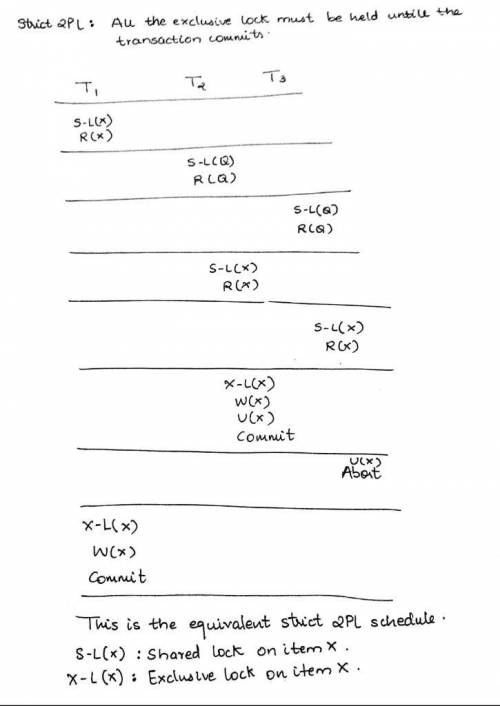
Computers and Technology, 19.05.2020 18:03 dave92
Given the following schedule, show the locks that will occur and the subsequent schedule. Assume that strict 2PL is in effect, with no deadlock prevention and no starvation prevention. Assume that upgrading locks are allowed, downgrades are not. Assume that requests will be satisfied in the order of arrival if possible.
T1:R(X), T2:R(Q), T3:R(Q), T(2):R(X), T3:R(X), T2:W(X), T2:Commit, T3:Abort, T1:W(X), T1:Commit

Answers: 3
Another question on Computers and Technology

Computers and Technology, 21.06.2019 17:00
In microsoft word, you can change the look of paragraphs by:
Answers: 1

Computers and Technology, 22.06.2019 10:00
Jackson is teaching the decimal number system. he wants his students to know how to expand numbers by powers of 10. which is the correct order in which digits are assigned values in the decimal number system?
Answers: 1

Computers and Technology, 23.06.2019 17:00
What does the faves button do? a. users mark a web page as a favorite b. leads other readers to favor a specific page c. readers sort and align their favicons, or favorite icons d. leads users to a message board where they can post questions
Answers: 1

Computers and Technology, 23.06.2019 17:30
When making changes to optimize part of a processor, it is often the case that speeding up one type of instruction comes at the cost of slowing down something else. for example, if we put in a complicated fast floating-point unit, that takes space, and something might have to be moved farther away from the middle to accommodate it, adding an extra cycle in delay to reach that unit. the basic amdahl's law equation does not take into account this trade-off. a. if the new fast floating-point unit speeds up floating-point operations by, on average, 2ă—, and floating-point operations take 20% of the original program's execution time, what is the overall speedup (ignoring the penalty to any other instructions)? b. now assume that speeding up the floating-point unit slowed down data cache accesses, resulting in a 1.5ă— slowdown (or 2/3 speedup). data cache accesses consume 10% of the execution time. what is the overall speedup now? c. after implementing the new floating-point operations, what percentage of execution time is spent on floating-point operations? what percentage is spent on data cache accesses?
Answers: 2
You know the right answer?
Given the following schedule, show the locks that will occur and the subsequent schedule. Assume tha...
Questions

Mathematics, 25.05.2021 21:40













Mathematics, 25.05.2021 21:40



Mathematics, 25.05.2021 21:40


Mathematics, 25.05.2021 21:40




